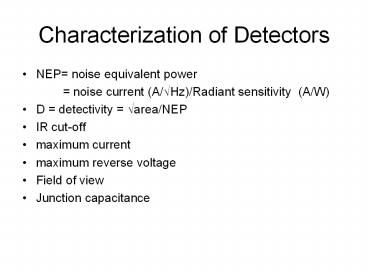Characterization of Detectors - PowerPoint PPT Presentation
Title:
Characterization of Detectors
Description:
Combines PE effect with electron multiplication to provide very ... Can detect single photons. -V. hf. e- Anode. Dynode. chain. Cathode. Microchannel plates ... – PowerPoint PPT presentation
Number of Views:35
Avg rating:3.0/5.0
Title: Characterization of Detectors
1
Characterization of Detectors
- NEP noise equivalent power
- noise current (A/?Hz)/Radiant
sensitivity (A/W) - D detectivity ?area/NEP
- IR cut-off
- maximum current
- maximum reverse voltage
- Field of view
- Junction capacitance
2
Photomultipliers
e
e
e
e
hf
e
e
PE effect
Secondary electron emission
Electron multiplication
3
Photomultiplier tube
hf
e-
Anode
Dynode chain
Cathode
-V
- Combines PE effect with electron multiplication
to provide very high detection sensitivity - Can detect single photons.
4
Microchannel plates
- The principle of the photomultiplier tube can be
extended to an array of photomultipliers - This way one can obtain spatial resolution
- Biggest application is in night vision goggles
for military and civilian use
5
Microchannel plates
- MCPs consist of arrays of tiny tubes
- Each tube is coated with a photomultiplying film
- The tubes are about 10 microns wide
http//hea-www.harvard.edu/HRC/mcp/mcp.html
6
MCP array structure
http//hea-www.harvard.edu/HRC/mcp/mcp.html
7
MCP fabrication
http//hea-www.harvard.edu/HRC/mcp/mcp.html
8
Disadvantages of Photomultiplers as sensors
- Need expensive and fiddly high vacuum equipment
- Expensive
- Fragile
- Bulky
9
Photoconductors
- As well as liberating electrons from the surface
of materials, we can excite mobile electrons
inside materials - The most useful class of materials to do this
are semiconductors - The mobile electrons can be measured as a
current proportional to the intensity of the
incident radiation - Need to understand semiconductors.
10
Photoelectric effect with Energy Bands
Evac
Ef
Semiconductor Band gap EgEc-Ev
11
Photoconductivity
12
Photoconductors
- Eg (1 eV) can be made smaller than metal work
functions f (5 eV) - Only photons with Energy EhfgtEg are detected
- This puts a lower limit on the frequency detected
- Broadly speaking, metals work with UV,
semiconductors with optical
13
Band gap Engineering
- Semiconductors can be made with a band gap
tailored for a particular frequency, depending on
the application. - Wide band gap semiconductors good for UV light
- III-V semiconductors promising new materials
14
Example A GaN based UV detector
This is a photoconductor
15
Response Function of UV detector
16
Choose the material for the photon energy
required.
- Band-Gap adjustable by adding Al from 3.4 to 6.2
eV - Band gap is direct ( efficient)
- Material is robust































